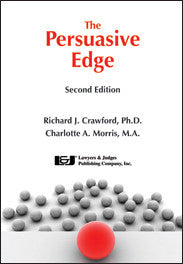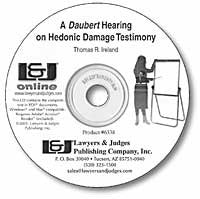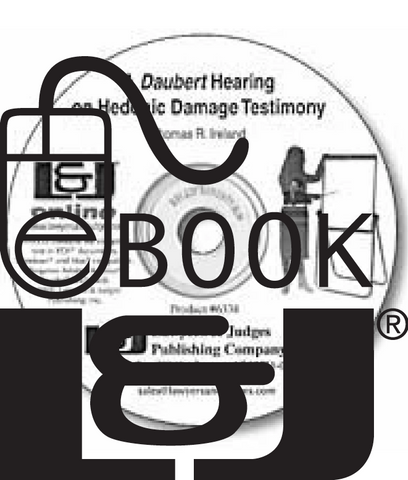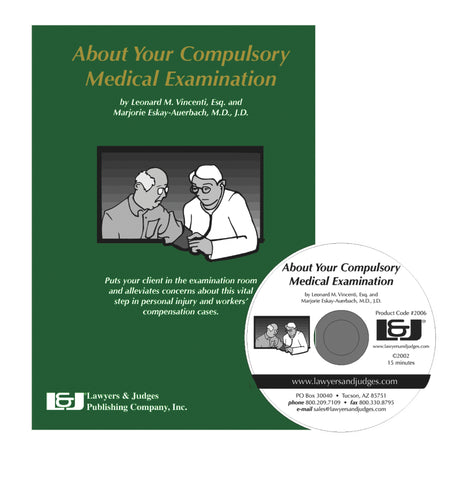
Persuasive Edge Second Edition
- Authors: Richard J. Crawford, Charlotte A. Morris
- ISBN-10: 1-933264-99-3
- ISBN-13: 978-1-933264-99-8
- Copyright Date Ed: April 1, 2011
- Pages: 256
- Binding Information: Softbound
- Size: 6 x 9 inches (US)
Purposeful communication will strengthen your ability to persuade. Drawing on the premise that persuasion must be purposeful, The Persuasive Edge lays out the case for making meaningful choices at each stage in trial preparation and at trial. The Persuasive Edge is a must for every trial lawyer, teacher and student of law or communication, and anyone else whose practice or profession depends on human persuasion.
This straight-forward discussion combines the best academic conclusions from the psychology of human persuasion and decision-making with the practical knowledge acquired from litigation throughout the United States, to offer you a more purposeful and practical approach to improving your influence and advocacy. The authors’ extensive experience as trial consultants has given them the opportunity to test modern persuasion techniques and research by working inside jury trials and conducting interviews with thousands of real and mock jurors in a wide variety of civil and criminal cases and training opportunities. This wealth of experience and unique perspective will assist you in creating a persuasive strategy for all aspects of legal practice, but especially within the jury trial. This book is not an abstract discussion of communication and persuasion theory, but a reference work designed to offer you practical and concrete techniques for improving your persuasive communication skills.
The authors begin by identifying communication choices that will help you create a persuasive strategy for any situation inside and outside of the courtroom. Next, they demonstrate how the key components of personal credibility allow you to build an honest relationship with the jury, and offer specific techniques for capturing juror attention and securing juror commitment from the very start of every trial. They devote three chapters to the approach, mechanics and strategies of effective jury selection, including good voir dire question design, sound strike strategies, and techniques for improving your efficacy when voir dire is limited. They also identify the essential elements of powerful and persuasive opening statements and offer extensive tips and techniques for all witness examinations, and excellent methods for presenting compelling closing arguments. This new edition offers updated and practical suggestions for the effective use of advanced technology to visually enhance your persuasive strategy for every jury trial, and provides rare and insightful advice about improving your persuasive effectiveness and influence with judges.
Regardless of your specialty or years of experience, your advocacy will be enhanced by the deliberate communication choices identified and illustrated in this book. For everyone working, teaching or studying in the legal arena, this advanced guide to purposeful persuasion will change the way you communicate for the better.
This book is also available as an eBook. Click here to purchase and download:
Table of Contents
Chapter 1: Developing a Practical Approach to Persuasion
Definitions and Parameters for This Book
The Lawyer’s Continuous Persuasion Campaign
Persuasion is Purposeful: Always Have a Communication Strategy and Clear Goals
Seven Major Communication Choices
1. Arrangement or sequence choices
2. Select and edit all of your data
3. Make careful delivery choices
4. Word choice: a matter of priority
5. Choose the persuasion site
6. Match your appeal focus to the receiver
7. Decide what to disclose about yourself
Using the Choice-Making Approach in Non-Jury Settings
Getting witness cooperation before the deposition or trial
Making choices related to office settings
Persuading the judge
Negotiating and bargaining
The Jury Trial: The Beginning of Post-Trial Persuasion
Chapter 2: Building an Honest Relationship with the Jury
You Are the Central Persuasion Equation
Credibility is a Matter of Substance and Style
The Psychology of Evidence: Three Conclusions
1. Evidence is perceptual
2. The advocate shapes and affects the evidence
3. The advocate as a “witness” during trial
How the Psychology-of-Evidence Conclusions Should Affect Communication Behavior at Trial
Do Not Try to Hide from the Jury
Three Credibility Factors
Communicating Your Competence to the Jury
1. Preparation is most important
2. Carefully work out your opening lines
3. Use the legal objection to display confidence and competence
4. Move with purpose
5. Demonstrate your sense of purpose and direction
Getting the Jury to Trust You
1. Admit mistakes to the jury
2. Identify the weaknesses in your own case
3. Use legal objection grounds to assert your integrity
Getting the Jury to Like You
1. Find the right formula for self-disclosure
2. Use your humanness to reduce the psychological distance between you and the jury
3. Keep the balance between being combative and courteous
Identify Focus Problems in Your Self-Image
Objectively Look at Your Image Projections in Front of a Jury
How to Begin Making Image-Projection “Corrections”
Putting Persuasion and Credibility into Perspective
Chapter 3: Simple Tools for Getting Jurors’ Attention
The Form versus Substance Dilemma
Holding Juror Attention is Totally Your Responsibility
Communicate Your Commitment with Voice and Body
Use Vocal Force to Carry Your Message
Use Vocal Pitch to Hold Attention
Rate Patterns as Persuasive Tools
Integrate the Three Delivery Variables
Use Courtroom Space to Your Advantage
Persuasion through Nonverbal Communication
1. Appear at ease in the courtroom
2. Avoid any social interactions with your opponents
3. Be aware of the materials on your table
4. Avoid displaying any negative social habits
5. Be attentive to the judge’s ritualistic opening remarks
Let the Message Dominate
Gender Differences in Verbal and Nonverbal Behavior
The Case against Using Written Notes
Exceptions to the no written notes rule
The danger of memorizing a written speech
Break down your speech into a series of mini speeches
Consider the use of mnemonic systems
Another organizational method for recall
Keeping Presentation Matters in Proper Perspective
Chapter 4: Persuasion in Voir Dire
The Seven Goals of Attorney-Conducted Voir Dire
What Potential Jurors Expect
The Approach to Attorney-Conducted Voir Dire
Get to Know Your Jurors
Preparing for Voir Dire
Identify the Issues You Need to Discuss
Case-specific topics
Create a Profile of Desirable and Undesirable Juror Traits
Crafting the Questions
Not All Questions are Created Equal
Open-ended
Closed-ended
Combination
Scaled response
Order Effect: Don’t Put the Cart before the Horse
Word Choice: It’s Not Just What You Say, It’s How You Say It
Tackling a Sensitive Topic
Allow Jurors to Advance or Argue Your Case
Avoid the Temptation to Argue
Exceptions to the Rule: Seeking Commitment from Jurors on Critical Aspects of Your Case
Practice Voir Dire
Anticipating and Overcoming Objections
Opening Remarks
Getting Started
Use Pace and Variety to Keep Things Interesting
Know When to Quit
What to Do with the Answers You Get
Accentuate the positive
Illuminate—then eliminate—the negative
Making Cause Challenges
Recording and Organizing the Information
Know the Rules but Don’t Be Afraid to Try and Change Them
Chapter 5: Developing a Strike Strategy
Four Peremptory Challenge Traps
1. The single-factor trap
2. The demographic trap
3. The nonverbal instinct trap
4. The war story trap
Every Case Requires Its Own Strategy
Additional Peremptory Challenge Factors
Jurors who mirror your client
Self-concept
Level of compassion
See the forest and the trees
Personality types or systems
Questions Designed to Discover Personality Types
Top Ten Questions for Civil and Criminal Cases
Civil case questions
Criminal case questions
Now You Have a Jury: How to Continue the Campaign You Started in Voir Dire
Opening statement
Direct and cross-examination
Closing argument
Conclusion
Chapter 6: What to Do When Attorney-Conducted Voir Dire is Strictly Limited or Not Allowed
Judge-Conducted Voir Dire
1. Submit a pre-trial motion for attorney-conducted and/or individual sequestered voir dire
2. Ask to submit your own questions
3. Ask for the use of a supplemental juror questionnaire
4. Conduct a pre-trial investigation of jurors
The Ten-Minute Voir Dire: What to Do When Your Time is Limited
The Use of Supplemental Juror Questionnaires
Make your request early and offer sound reasons for its use
Keep it simple
Timing is everything
Questionnaire construction
Making Use of What You Learn from SJQs
Create a card file system
Create a single-page summary
Rate each prospective juror
Follow-Up Questioning
Forging a New Voir Dire Frontier
Chapter 7: Securing Juror Commitment during Opening Statement
Put a Premium on Opening
Steer Clear of the Road Map “Trap”
What are the Limits?
Use Credibility Capital with Care
Psychological Presentation of Evidence during Opening Statements
Jurors Won’t Wait for the Evidence before Taking Sides
Convince the Majority during Your Opening
Ten Essential Elements of Effective Opening Statements
1. The power of narration
2. Perspective
3. Motive
4. Themes
5. Sequencing and word choice
6. Present tense speech
7. Directness
8. Specificity
9. Embrace your weaknesses
10. Set the standard
How Much Should You Mention Your Opponent’s Case?
Voir Dire and the Opening Statement as a Duet
Beginning Your Opening Statement
The first minute is prime time
Avoid wasting prime time
Reload your silver bullets for your concluding paragraph
Preventing and Responding to Objections
Deliver Several Statements as if You are a Witness
Do Not Wait to Mention Damages
How Long Should Your Opening Be?
When Should You Compose the Opening Statement?
Never Waive or Reserve Your Opening
The Defense Can Have the Opening Statement Advantage
Use the Best of What You Have and Who You Are
Chapter 8: Advancing Your Case while Witnesses Are on the Stand
Persuasion through Other People
Tend to Your Witnesses Long before Trial
Fourteen Things to Focus On: Preparing Witnesses for Direct Examination
1. Be honest about the scrutiny
2. Prepare your witnesses for proper eye contact
3. Let witnesses practice interacting with exhibits
4. Empower your witnesses to ask questions occasionally
5. Help your witnesses with posture and use of hands
6. Teach witnesses how to vary the pace of their testimony
7. Acknowledge the weaknesses in testimony
8. Watch out for negative mannerisms in your witnesses
9. Prepare for levels of denial or affirmation
10. Help the witness return to the emotions of the original moment
11. Help your witness use more effective language
12. Help witnesses avoid the “you were coached” trap
13. Always test your witnesses with a hypothetical cross-examination
14. Appearance
Special Considerations for Expert Witnesses
1. Eliminate “shop talk”
2. Don’t hide the truth from experts
3. Look for teaching experience
4. The well-trod witness
5. Have an answer for the inevitable
6. Get right down to business
Six Tasks to Complete during Direct Examination
1. Be sure the jury knows how much you like and believe your witnesses
2. Retain eye contact while asking questions
3. Shield your witnesses by leaving nothing for your opponent
4. Mix some cross-examination with your direct examination
5. Control the sequence and drama of your witness’ testimony
6. Carefully select your witness order
Seek the Cooperation of a Hostile Witness before Attempting Cross-Examination
Composing and Delivering Cross-Examination Questions
Nine Cross-Examination Choices
1. Approach cross-examination as if it were a speech
2. Think of the witness as “irrelevant” during your examination
3. Hold the witness to one-syllable responses
4. Use your positive credibility as a cross-examination weapon
5. You may maintain an adversarial approach even with a “gentle” witness
6. At times, studiously avoid interrupting the witness
7. Let witnesses expose their own question-avoidance
8. Never give away your power and control
9. Adopt a four-step model for all major cross-examination challenges
Other Stylistic Considerations for Cross-Examination
Choose among a variety of leading question constructions
Use some theatrics during delivery of a leading question
Occasionally begin questioning while still seated
Don’t Let the Jury Know When a Witness Throws You a Curve
Cross-Examining Witnesses Who Evoke Sympathy
Consider the consequences of asking no questions
Lead such witnesses in an inquiring manner
Try to avoid cross-examining hostile witnesses if you have not met with them before trial
Special Considerations for Child Witnesses
Become informed about child development and child psychology
Do not abandon your witness examination principles
Protect or impeach children before and after their testimony
Use electronic recording technology
Efforts to impeach a child may backfire
When Criminal Defendants Should Testify
Mingle Substance and Hard Work with the Process of Managing Witnesses
Chapter 9: Maximizing Persuasion Potential during Closing Argument
The Role of Closing Arguments
How Closing Argument Differs from Opening Statement
Consistency is Key
Finish What You Started: The Connection between Opening Statement and Closing Argument
Begin with strength
Perspective
Motives
Narration
Themes
Embracing your weaknesses
Twelve Do’s and Don’ts for Closing Argument
1. Keep the speech in clear focus
2. Draw clear conclusions in your closing
3. Bring witnesses back to “testify”
4. Be persuasive and poetic
5. Inoculate the jury against your opponent’s upcoming summation speech
6. Prepare your rebuttal speech in advance
7. Prepare the jury to make the difficult decisions
8. Let jurors know you were paying attention
9. Always refer to the jury instructions
10. Use analogies and metaphors with caution
11. Empower the jury
12. Conclude with directness, confidence, and eloquence
The Persuasive Power of Passion
Close with Personal Authenticity
Chapter 10: The Power of Visual Persuasion
Overarching Principles for Visual Persuasion
Explore your options early
Match the presentation to your purpose
Practice still makes perfect
Don’t stake everything on visual presentations
Five Common Mistakes When Using Visual Aids
1. Failure to get feedback
2. Ineffective use of documents
3. Lack of preparation for the use of transcripts
4. Haphazard use of photographs
5. Too much or too little information on a timeline
Opening Statement: A Prime Graphic Opportunity
Using Graphic Aids with Witnesses
Cross-Examination Techniques
Using Graphics during Closing Argument
Seven Additional Considerations for the Use of Visual Aids
1. Make sure the courtroom stage is ready
2. Find ways to involve the jury
3. Don’t pass pictures and charts among the jurors
4. Stop just short of the most grisly depictions
5. Keep the presentation moving
6. The strategic use of titles
7. Variety is the spice of life (and trial)
In the Courtroom
Everything in Moderation
Chapter 11: Expanding Your Trial Strategy and Staging Techniques
Consider a “New” Approach to Taking Most Depositions
1. Take care to mask your value judgments about the witness and the case
2. Create an atmosphere for problem-solving
3. Don’t let your strategy prevent you from going where the witness takes you
4. Listening is an active behavior, not passive
5. Use positive feedback to encourage greater participation
Carefully Divide Duties with Co-Counsel
Use Spectator Support
Sharing Voir Dire with Your Client
Five Linguistic Considerations for Trial
1. Don’t help to humanize your opponent
2. Package the fear of a loss in the language of certain victory
3. Make your opponents appear to lack confidence
4. Characterize your opponent’s case as a story
5. Take the “we versus they” stance
Enlist the “Great American Myths”
Persuasion and the Legal Objection
Let the Jury Draw Some Final Inferences
Experiments and Demonstrations in Court
Develop Your Own Tactical Use of Passion
Carry a Special Message for the Jury during Closing
Considerations for “Mega-Trials”
The Unlimited Boundaries of Jury Persuasion
Chapter 12: Communicating More Effectively with the Judge
Examine Your Goals
There is No Magic Formula for Persuading Judges
Judges are People Too
Know the Judge’s Reputation
Using Personal Knowledge about the Judge
Strategically Arrange the Order of Motions
Respect the Court’s Time Constraints
Accept Bad Rulings
Facing a Hostile Judge: A Two-Step Approach
Public Communication Exchanges with the Court
Chapter 13: Using Trial Consultants
When Do You Really Need a Trial Consultant?
Three Selection Considerations
1. Academic background
2. Experience and specialty
3. Magic potion claims
Protecting the Confidentiality of a Consultant’s Work
Common Trial Consulting Services
1. Small group research
2. Witness preparation
3. Jury selection preparation and assistance
4. Survey research
5. Post-trial juror interviews
Be a Bit Skeptical about Research Findings
Introduce Your Consultant to the Judge and Jurors
Referring to an Opponent’s Trial Consultant
What Do You Have a Right to Expect from a Trial Consultant?




